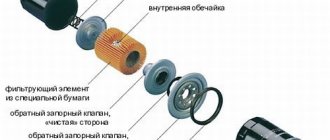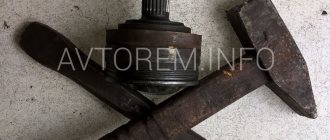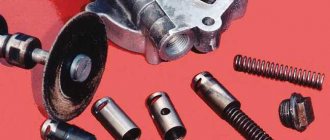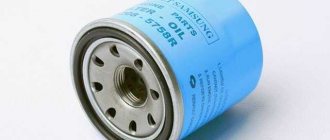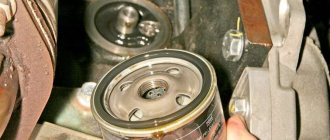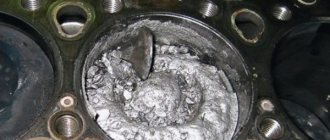Ideally, the oil filter is screwed in by hand for removal when replacing in a similar way. In practice, drivers and service station employees overtighten the threads. There is a need for an oil filter puller to remove it.
Universal oil filter remover
The main problem is the poor location of the consumable element, the dense arrangement of units under the hood of the car, several standard sizes of filters and a rubber seal stuck to the ebb, so the most convenient device for removing the oil filter for a car of a particular brand is selected.
How to make a chain puller with your own hands
The next most popular material for a puller is a loop made from a bicycle chain (or timing chain, depending on who you are).
Such devices are produced industrially and are popular among drivers. If you make a chain puller “according to science,” there is a standard drawing.
A lever is cut out of a massive open-end wrench - a handle in the shape of an ice ax. One end of the chain is secured with a pin at the base of the lever. And the second one clings to the tooth, depending on the diameter of the filter.
The mechanism works flawlessly: the stronger the force when unscrewing, the more powerful the grip. The housing may be damaged, so a puller will not be suitable for tightening. Or you need to lay a piece of thick rags.
Making it is quite simple: take a steel hexagon and attach a chain to it in one or two rows. You can just weld it.
If you are working only with your own car, you need to accurately calculate the length of the chain based on the diameter of the filter housing.
A more universal device (regarding the diameter) is made from a long spark plug head. We drill a groove and thread a double-row chain into it. After that, we simply close the links and get a ring. When tightened around the filter, the chain simply screws onto the head. Therefore, a “two-row” is needed; a thin chain will not wrap around the axis.
Instead of a spark plug head, you can use a steel hexagon (the main thing is that the size matches the key). On the one hand, grooves are cut across the axis of rotation. Then we drill holes for the studs (already along the hexagon). We insert the open chain links and hammer in the studs.
Similar samples are also available for sale. If you do the work carefully, a homemade puller is no different from an industrially manufactured one.
Where can I use such a universal key?
This tool can be used in many jobs. If the length of the chain allows, it can be used to unscrew the oil filter in a car. And in general, it is convenient to use it in hard-to-reach places where it is not possible to work with a gas or adjustable wrench.
There is another option for manufacturing a similar tool, where only one side of the chain is welded to the nut. At the opposite end of the nut, a hook is welded to which the chain will cling. In this case, a longer chain is used here. This allows you to adjust the diameter of the circle depending on need.
But even the simplest version of a universal tool, discussed today, allows you to perform various jobs that are inaccessible to a regular key. And you can start checking the functionality of the device from the same bicycle frame from which the chain was removed. For example, you can try to unscrew the pedal carriage nut.
PHOTO: YouTube.com The key fits perfectly under the nut, while clamping it as tightly as possible
Interestingly, we even managed to tighten the carriage nut a little, despite the fact that the bike had been lying in a damp attic for a long time.
Another advantage of the key
Sometimes it is impossible to unscrew plastic parts, for example, when replacing a water filter element. It is clear that the gas wrench is clearly not an assistant here - the pressure will simply crush the plastic. But with our device this can be done due to the uniform distribution of pressure along the entire circumference of the plastic cover.
In general, such a tool is very convenient to use. At the same time, you can use it to unscrew even small nuts. But to unscrew larger, and especially stuck parts, the homemade wrench will have to be strengthened and made more powerful.
PHOTO: YouTube.com This universal tool makes it easy to unscrew even fragile plastic parts
Types of pullers
Do-it-yourself ball joint remover
Essentially there are only two types and they work the same:
- Ribbon loop. It’s just a handle in which a slot is made and a loop is inserted there; it can be made of a soft material (such as rubber), or it can be made of a hard one, but it must bend (for example, a thin sheet of metal). Place it on top and tighten it with a handle, then simply unscrew the oil filter element
- Chain loop. Everything is the same, only the loop is made from a chain, many write that this option is much stronger, because the first type (rubber or thin metal) can simply break
Some craftsmen say that pullers are the best option - but what is it really like?
Other replacement options
The men used a variety of available tools instead of the usual wrench.
Pliers
Simple and reliable - tested more than once. Using pliers incorrectly is simply impossible! Grab yourself tightly and twist!
adjustable wrench
Of course, if a master finds himself in such a situation, he may well have an adjustable wrench.
You will only need to adjust it so that the fastener being unscrewed is firmly grasped by the jaws of the key.
Files
Two files will do the job. Their canvases at one edge must be securely secured with wire, tape, a suitable ring, etc.
After this, the files are placed on both sides of the fastener. This is done so that the nut is approximately in the middle of the blades. Holding both handles of the file at the same time, they begin to unscrew.
Small vise
An option familiar to handicraft craftsmen who have small vices. The nut is secured in a vice and then unscrewed.
Calipers
Another alternative option is a caliper. They operate similarly to the options already described.
It is important not to forget about your own safety! If the caliper comes off the fastener, it can cause injury. Sometimes men risk performing the necessary action even with the help of large scissors
They clamp the nut with the handles of scissors
Sometimes men risk performing the necessary action even with the help of large scissors. They clamp the nut with the handles of scissors.
We do not think that this operation should be repeated. Especially if you do not have such experience and you do not feel confident in performing the procedure.
Wooden strip and nylon tape
Not the most traditional way, but why not try it if you don’t have anything more suitable at hand.
A nylon rope (at least 15 cm will be needed) is tied tightly in the middle of the wooden plank. The free edge of the nylon begins to be wound around the nut. Twist the rope until it ends. Now unscrew the bar. Together with it and the nylon, the fasteners will move from place.
How and with what can this be done?
Diagnosis of faults, repair and replacement of the oil pump VAZ 2110-12 with your own hands
We suggest you familiarize yourself with the main methods that will allow you to dismantle the filter device with your own hands.
User Andrey Florida in his video explained how to replace the oil filter and what options are available for dismantling it.
Can you twist it by hand?
There are special tools for dismantling the filter device. But you can also unscrew it yourself. If the sticking of the device is strong, a tool or improvised devices will be required for dismantling.
Special key
You can use a special key to unscrew it. This is an effective method, but to implement it you will need to purchase a tool. You will find several key options on sale:
- chain;
- clamping tool;
- tape;
- screw puller.
How to use it correctly?
To unscrew it with a chain or other special wrench, hook the filter device with a tool, securely fix it and remove it by turning it counterclockwise.
Rope (belt) and screwdriver
To remove the device without a tool, use a belt or rope with a screwdriver:
- A screwdriver is used to pierce the body of the filter device, as a result of which the tool is used as a lever. When using a screwdriver, you need to pierce the element right through, this will make twisting more effective.
- When using a belt or rope, the dismantling method simulates the use of a special key. The strap should be wide and made of leather or leatherette. A loop is made, after which it is tightened on the device itself counterclockwise. For quick dismantling, give a sharp tug on the rope or strap. The removal process may be difficult due to the strap slipping. Then insert a piece of sandpaper into the loop itself and perform the described steps again.
Hammer and long screwdriver
This method of unscrewing a part is similar to the screwdriver method. Its implementation is relevant if you pierced the filter, but could not move it from its place. Then dismantling the device is possible by applying force from blows with a hammer to the screwdriver handle.
Hammer and chisel
If these dismantling methods do not help or the housing of the filter device is damaged, then use a chisel instead of a screwdriver. Make a small notch on the part for the chisel to rest against. We begin to hit the instrument with a hammer. This usually helps to quickly unscrew the filter.
Homemade instrument
You can change the filter and dismantle the device with a homemade puller. The operating principle of such a tool is identical to a special key.
You will learn about making your own dismantling tool from the video. The material was filmed and made public by the kv3st channel.
You need to build such a device yourself:
- You will need a bicycle chain, or rather a section of it. When dismantling the filter in domestically produced VAZ cars, the optimal chain size is 30 links.
- The chain is connected into a ring; a lock or rivet is used for fixation.
- You will need an unnecessary head from a 19 or 22 socket wrench. You need to make a cut in it that matches the size of the bicycle chain.
- Install the extension into the connecting square hole on the head. Use an awl or ratchet. For reliable fixation, the diameter of the extension must be equal to the size of the hole.
- Unscrew the filter device by turning it counterclockwise.
The use of this method is relevant if there is free space around the device. Hook the oil filter housing with the tool and use its handles as a lever. Be careful not to damage other powertrain components. Be careful as some oil will come out of the filter when removing it.
Making a universal wrench: minimum words and maximum photos
To make this fantastically simple tool you will need:
- unnecessary bicycle chain;
- a wooden block of such thickness that you can easily grasp it with your hand;
- a sufficiently long screw with a nut;
- drill with a diameter corresponding to the size of the screw.
From a wooden block we measure a piece with a length slightly exceeding the width of the palm.
Carefully cut off the measured piece.
2-3 cm from the edge we mark a place for attaching the chain.
We select a drill with a diameter corresponding to the size of the screw.
We drill a through hole into which the screw will fit freely and insert it there. Then we take the chain from which our universal wrench will be made, and find a collapsible link in it that allows us to open it.
Use an awl to remove the locking pad, disassemble the collapsible link, and then open the chain.
We put one of the outer links of the open chain on the tail of the screw.
We fix the link with a nut, which we then tighten thoroughly.
And now our universal wrench, which we just intended to buy, is ready. Now let's see how our miracle tool works and how to use it.
Why won't the oil filter unscrew?
Replacing the oil filter
To unscrew the old oil filter, you need to place the car on a pit or raise it using a lift. After this, you need to unscrew the consumable element, but this may be difficult. If the old oil filter cannot be unscrewed, this happens for the following reasons:
- The filter is stuck. The engine becomes very hot during operation, which leads to the melting of elements with low heat resistance. These elements include the rubber gasket that connects the oil filter to the engine. It melts a little and sticks to the engine. If motor oil gets on it, then it becomes a kind of adhesive element, which will make it even more difficult to unscrew the oil filter;
- The filter was tightly screwed on. When replacing the filter, it must be screwed tightly so that the rubber band is pressed tightly against the engine. In this case, the filter is often screwed on too tightly, especially when a special key is used. Combined with the melting of the gasket, it becomes almost impossible to unscrew it.
It is important that the filter is not located in the most convenient place, and it becomes impossible to apply maximum physical force. In addition, when working, your hands end up in oil, which causes slipping when trying to unscrew the filter element.
Inconveniences for the driver
Car modifications have individual principles for attaching the oil filter. What remains common is the lack of space around them, since the layout of the power units is so compact that it is almost impossible to “crawl” in to screw together the oil cup. Difficulties include the adhesion of rubber seals to metal.
Based on the above, they conclude that a specific engine requires “its own” device or universal puller. When developing your own design, you need to focus on factory analogues of oil filter pullers sold in car dealerships.
Why might this be needed?
Car manufacturers recommend changing the engine oil every 15 thousand kilometers. Under difficult operating conditions, for example, when traveling with a trailer, the lubricant is changed more often. When changing the oil, it is advisable to change the oil filter.
Many car enthusiasts do not understand the reasons for replacing the oil filter when the lubricant is changed. The engine is the heart of the car; it is subject to the greatest wear and tear, since it bears the main load. The engine fluid being poured contains foreign particles that have a bad effect on the operation of the engine. An oil filter is designed to filter out these particles. The more it is worn, the worse the quality of the lubricant becomes, and this, in turn, affects engine wear.
Structure of the filter element
It is impossible to determine the suitability of an oil filter by appearance. It is also difficult to draw conclusions about the need for replacement based on mileage. The filter element works constantly, even when the engine is idling, so its wear depends not on mileage, but on engine hours. Some drivers, when changing the oil, neglect to replace the filter element, considering it unnecessary.
When choosing a replacement product, it is important to focus not on its appearance, but on its content. Drivers with an aggressive driving style are better off installing expensive products.
This is due to the fact that when driving fast, hard braking or accelerating, the engine requires a large amount of oil. Expensive filters have synthetic elements that can withstand loads and high temperatures well, allowing the oil to pass through quickly. Analogues have felt-based elements through which the lubricant passes longer than through synthetic material. These products are suitable for lovers of a quiet ride.
Type of pullers
Different housing geometries require their own individual oil cleaner removal tools in a long line of removal tools. Their casings are made of durable metal. The surfaces are treated with special coatings that prevent the occurrence of chemical corrosive reactions. Some glasses are equipped with plastic overlays that make it easier for car enthusiasts and service station mechanics to quickly disconnect oil filters from power units.
The industry produces several types of pullers that are actively used in practice. These include:
- products where the main element is a belt;
- devices with circuits;
- belt pullers;
- products with special grips;
- products in the form of crab claws and so on.
They can be called universal, conditionally, since they do not have to be used for all modifications of cars.
The limitation comes from the many different engine layouts. For example, a chain oil filter puller is ideal for one brand of engine, but is unsuitable for another car. Does not fit in diameter or other metric parameters. The availability of oil filters for each brand of vehicle is individual. Some have a good approach to the site, others are fenced off by installed parts, partitions, and so on.
Why might this be needed?
Car manufacturers recommend changing the engine oil every 15 thousand kilometers. Under difficult operating conditions, for example, when traveling with a trailer, the lubricant is changed more often. When changing the oil, it is advisable to change the oil filter.
Many car enthusiasts do not understand the reasons for replacing the oil filter when the lubricant is changed. The engine is the heart of the car; it is subject to the greatest wear and tear, since it bears the main load. The engine fluid being poured contains foreign particles that have a bad effect on the operation of the engine. An oil filter is designed to filter out these particles. The more it is worn, the worse the quality of the lubricant becomes, and this, in turn, affects engine wear.
Structure of the filter element
It is impossible to determine the suitability of an oil filter by appearance. It is also difficult to draw conclusions about the need for replacement based on mileage. The filter element works constantly, even when the engine is idling, so its wear depends not on mileage, but on engine hours. Some drivers, when changing the oil, neglect to replace the filter element, considering it unnecessary.
When choosing a replacement product, it is important to focus not on its appearance, but on its content. Drivers with an aggressive driving style are better off installing expensive products.
This is due to the fact that when driving fast, hard braking or accelerating, the engine requires a large amount of oil. Expensive filters have synthetic elements that can withstand loads and high temperatures well, allowing the oil to pass through quickly. Analogues have felt-based elements through which the lubricant passes longer than through synthetic material. These products are suitable for lovers of a quiet ride.
When should you change your bicycle chain?
A good bicycle chain lubrication can significantly increase the service life of the entire system responsible for movement. At the same time, you need to be able to notice the moments when it begins to need maintenance or repair.
Excessive wear on a bicycle chain not only causes constant discomfort while riding, but also causes active deformation of the chainrings. If a worn chain is left unattended for a long period of time, it is guaranteed to lead to the need to replace a whole set of expensive mechanisms.
In order to assess its condition as objectively as possible, it is necessary to look not at the mileage, but first of all to measure the length of all its links. The chain length in normal condition is approximately 305 mm. The reason for its replacement is its stretching to 308 mm or more.
Purpose of the puller
According to the car's operating manual, problems with how to unscrew the oil filter yourself cannot arise in principle:
- When changing the oil, a new filter is installed;
- the sealing rubber must be lubricated with lithol;
- tighten the consumable element by hand;
- tighten 1/3 turn with slight force.
In this case, the rubber sealing ring does not stick to the ebb of the engine housing; the filter can be removed by hand without a puller. In case of severe contamination of the housing, use a piece of sandpaper - the hand does not slip, the abrasive material ensures reliable grip of the palm on the filter housing.
A piece of sandpaper for unscrewing the oil filter
These requirements are often violated by the users themselves:
- there is no lubrication of the rubber ring; at high pressure and temperature it loses elasticity and sticks to the filter housing and the engine seating surface;
- It is not clear for what purpose the car owner tightens the thread with both hands, tightening it and flattening the rubber seal.
Even in this case, you can try to do without a puller:
- tap the rim in a circle on the side of the sealing ring to ensure its mobility relative to the filter housing or the ebb of the groove of the seating surface;
- pierce the rubber seal with a narrow screwdriver, separating it from the low tide side.
Tapping the rim in a circle
In all other cases, you have to use special devices to twist this consumable item. Since access to the filter is difficult, and its outer size differs on different machines, the question of which puller is better, in principle, does not make sense for the following reasons:
- there are turnkey or head pullers with their own handles;
- some tools are made for a specific filter diameter;
- other pullers have adjustable gripping devices of several sizes;
- Universal sliding devices are suitable for any passenger car filters.
Purpose of the oil filter puller
To purchase or independently manufacture a specific puller model, you should familiarize yourself with the design of each of them.
Complete set of bicycle repair tools
An avid cyclist will not get by with a standard repair kit. It is necessary to add more tools to the kit, allowing you to completely repair any breakdowns yourself, as well as improve the quality of the bike. Additional tools include:
- extended set of keys;
- pullers;
- mounting blades;
- wire cutters;
- hydraulic set;
- strain gauge;
- caliber;
- stands.
Now in more detail about each element.
Additional keys
If your bike model has ball bearings, cone wrenches will be a must-have. They are needed for timely cleaning of bushings.
To remove the pedal, a specially shaped wrench is used. It is ideal for road bike models with little clearance between pedal and crank.
Flat and Phillips screwdrivers that are universal for various jobs are also useful.
Bicycle pullers
In order to remove the connecting rod, it is worth purchasing a square puller. Before buying a tool, make sure that the connecting rod is attached using the “square” system. Typically, higher-end bikes may have a different mount and not require a special puller.
Carriage pullers are used to remove the cups that secure the carriage to the bike. Depending on the bicycle model, you need to select a carriage puller with a different spline head diameter.
An important purchase will be a ratchet remover. This is a must-have tool, since disconnecting the ratchet using other methods is quite problematic. The tool is a splined head
The tool is a splined head.
There is also a special cassette remover. To make working with it easier, it is recommended to buy a special whip in the kit.
Wire cutters
Wire cutters are used to repair gear shift cables. Wire cutters have a special advantage over a knife or other tools in the set that can be used for this purpose. They can be used to gently cut through the cable without deforming it. The edges will not be fluffy and the cable will last for a long time.
Stands
In order to independently and easily repair bicycles, it is worth acquiring two stands. You need to take care of buying a rack on which you can put the bike
It will also be important to purchase a special small stand for wheels, which is convenient for straightening the spokes
Crab-shaped puller
This puller has the necessary range of settings for different sizes of oil filters. It consists of two round metal plates, between which there are 3 clamps with claws. A rough pattern is applied to the working part of the legs to eliminate the possibility of slipping and ensure maximum engagement with the filter housing. The legs are fixed and clamped using special adjusting bolts.
First, the puller's legs are adjusted to the diameter of the filter, and the crab is put on it. As a reminder, to achieve the best grip, pull the clamps as tight as possible. After this, install a special key in the square groove of the device and unscrew the crab along with the filter.
The process of unscrewing the filter is completely identical to unscrewing the filter using a cup puller.
The main disadvantage of crab is its narrow range of regulation. This means that it has limitations on large and small oil filter sizes. Therefore, the purchase of such a puller in the future should correspond to the size of the filters used.
However, there is a certain advantage of the puller - it is the same ability to work in narrow spaces that are severely limited by the elements of the engine compartment.
What to look for when purchasing
An adjustable wrench is a universal tool with varying jaw sizes. It has a number of advantages:
- it replaces several models;
- if desired, you will purchase a tool with specially shaped jaws;
- There are models on sale with plastic handles, so they are comfortable to hold while working.
There were some downsides:
- since the head of the adjustable wrenches is quite large, it is difficult to work with the tool in hard-to-reach places;
- the sponge is not fixed securely, and it is not easy to unscrew a tightly tightened nut;
- During the operation of the key, the play increases;
- The position of the sponge needs to be adjusted.
Despite all the disadvantages, the adjustable wrench is easy to use, so hurry to get one.
How to unscrew the oil filter
There are special keys for this that can be purchased at car dealerships. But it happens that it is impossible to get to the filter with such a tool due to limited space. Or another situation: instead of a standard product, you installed a higher quality element with larger dimensions. In such cases, the question arises: how to unscrew the oil filter without a key? But first it’s worth identifying the reasons why the product cannot be turned away by hand. There are two of them:
- during the previous oil change, the filter was tightened too tightly with a wrench (this is typical for car repair shops);
- the product just got stuck because it hasn’t been changed for a long time.
Below are all the popular ways to replace an old filter with a new one. However, this product must be unscrewed by hand. There is also a trivial situation: maybe you just don’t have enough strength. Then invite a stronger assistant.
Using a screwdriver
The tool must be long: longer than the diameter of the filter. You just need to pierce it, and right through it. The screwdriver here plays the role of a lever, which should be sharp and thick. Don't forget to drain the oil first: however, some of it will still spill out, so take care in advance and place a suitable container down. It is worth noting: all filters turn counterclockwise.
Using a leather belt
A regular trouser shirt will do. You need to make a loop out of it and throw it over the body. The free end is a kind of lever.
If the belt turns, place a piece of sandpaper under it. If you have an alternator belt from a VAZ or other car at hand, you can use that too. The filter must be unscrewed.
Using a gas key
Removal in this way is only acceptable if there is enough space in your car and the tool can easily fit there. The handle of the tool will be the lever. However, fanaticism is not needed! Be careful not to roll anything else along the way.
Using a chisel and hammer
Everything is clear here: take a tool (it should be sharp), place it on the rim of the filter, closer to the engine (this makes it easier to remove). The blows must be strong and sharp.
Using a homemade tool
It makes sense to make a puller yourself, similar to the factory product. To do this you will need a regular bicycle chain. If it has 30 links, then this is an ideal option for the VAZ classic. The chain must be connected into a ring using a rivet or a regular lock. Next, take your used 19 or 22 socket head: you need to make a cut in it, the width of which corresponds to the width of the chain. This is where you need to insert it. To make it more convenient to unscrew the filter, insert a wrench or ratchet into the square hole of the head. All that remains is to smoothly twist the homemade puller counterclockwise.
When the old filter is unscrewed in one way or another, thoroughly wipe the seat with a rag, removing all particles of dirt. Fill the new filter with oil and screw it in by hand. Try to do this with force, but not excessively! Only after this can the filter replacement procedure be considered complete.
Chain assembly[edit]
When assembling the chain, it is necessary to overcome the tension of the rear derailleur spring, so an assistant will be appropriate here to hold the derailleur (or remove the chain from the system).
Place the chain so that the protruding pin faces your direction.
Grasp the link that does not have a pin protruding from it and guide the chain from right to left through the front and rear derailleurs. The rear derailleur has 2 “holes” next to the rollers that you need to thread the chain through. Connect the ends of the chain at the bottom against the resistance of the rear derailleur spring. Have an assistant hold the switch.
Place the link to be connected in the squeeze, on the stop that is closest to the fixing screw.
When adjusting the position of the chain, move the pin to the clamped pin so that they are coaxial.
Tighten the link with the fixing screw
Attention! Skipping this step may result in broken squeezer. Rotate the handle to press the pin into the link
Constantly monitor the degree of immersion of the pin in the adjacent ones - it should not be completely flush with the cheek, but stick out a fraction of a millimeter
Rotate the handle to press the pin into the link. Constantly monitor the degree of immersion of the pin in the adjacent ones - it should not be completely flush with the cheek, but stick out a fraction of a millimeter.
Remove the chain from the squeezer, check how symmetrically the pin fits
If necessary, adjust its position.
Check the mobility of the assembled link. If it bends tightly, then you need to grab the chain on both sides of the assembled link and forcefully bend it in the transverse direction.
If the belt option does not justify itself, we make a chain one
To make your own chain puller, you will need a piece of half-inch or inch used pipe with uncorroded, undamaged walls and a thread at one end. The length of the piece must be no less than the height of the filter. We select a suitable plug for the pipe so that it screws onto its thread. You'll also need a bicycle chain.
Bicycle chain and pipe
We drill a hole with a diameter of 9 mm in the center of the plug. Using a triangular file, we give it a square shape with our own hands. We carry out the processing until the dimensions of the hole are suitable for the ratchet wrench, or more precisely, for its end. The latter should fit into the resulting opening of the plug quite tightly, with almost no play. Screw the plug onto the end of the pipe and tighten it very tightly. To prevent it from unscrewing when using the puller, it is recommended to attach it to the pipe by welding.
As a last resort, you can try to crush the metal at the end of the thread using a dull chisel and hammer, but only carefully so as not to deform the pipe. We make markings on the pipe for drilling holes for the chain. To securely grip the filter, 2 pieces of it installed on the puller opposite the opposite ends of the cleaner are enough. But you can also make a 3rd hole, between the 2 outer ones, for another 1st chain. In this case, the puller will become more versatile, as it will allow you to unscrew filters with different height sizes.
Homemade device for securely grasping the filter
Having threaded a chain through one of the drilled holes in the pipe, we loop it around the filter, trying out how long the pieces will be needed. We measure out enough so that the puller, when unclamped, fits freely onto the cleaner. You can even make some supply of chain length for filters whose diameter is larger than that installed on the car. But we must take into account that it will be less convenient to work with such a puller. Along the measured length, we disassemble the chain into separate fragments - squeeze out the pins and separate the links at this point.
Having threaded the resulting sections through the holes in the pipe, we make loops out of them - we connect the links of the ends and press in the pins. To unscrew the filter, we put the puller loops on it and, if necessary, when the chains are too long, we manually turn the pipe counterclockwise, thereby removing the slack. Then we insert a ratchet wrench into the plug and, with its help, begin to dismantle the purifier.
Having decided to change the oil in their car themselves, many car owners are faced with an unexpected obstacle - the oil filter does not want to be unscrewed by hand.
Everything is complicated by the round shape of the filter element housing, which is impossible to grasp properly. It’s good if there is a car store nearby that sells special pullers of different types (they are chain, screw, end, belt, etc.), but what if there is no way to purchase a key, but you desperately need to remove the filter?
In fact, everything is much simpler than it might seem at first glance: there are several simple ways to remove the oil filter without a key. We will talk about them in detail in this article.
Methods for unscrewing the filter element
The following few methods will help the car owner cope with the problem on his own. They are 100% effective, so the element will definitely give in.
- Often the master simply does not have enough strength, so it makes sense to call a strong neighbor or friend for help.
- You can purchase a special key, the cost of which does not exceed 300 rubles. Thanks to it, the master will be able to easily and easily unscrew the element by hooking the key onto the body.
With this method, the filter is deformed, but since it must be replaced, this is not a problem.
A screwdriver and a rope will come to the driver’s aid (old timing belts or alternator belts are often used).
A loop is made around the element and pulled tightly with a screwdriver, after which you must try to unscrew it. It is important to ensure that the rope does not slip.
The walls of the element are usually made of soft material, so they are easy to break through.
First, drive a screwdriver all the way into the filter, and then unscrew it like a lever.
- The latter method is recommended to be used only in the most severe cases. You need to take a chisel and hit it with a hammer counterclockwise. The main thing is that the point of impact is closer to the attachment point.
Auto mechanics advise using the key method, but if you don’t have one, it’s better to use a long screwdriver.
